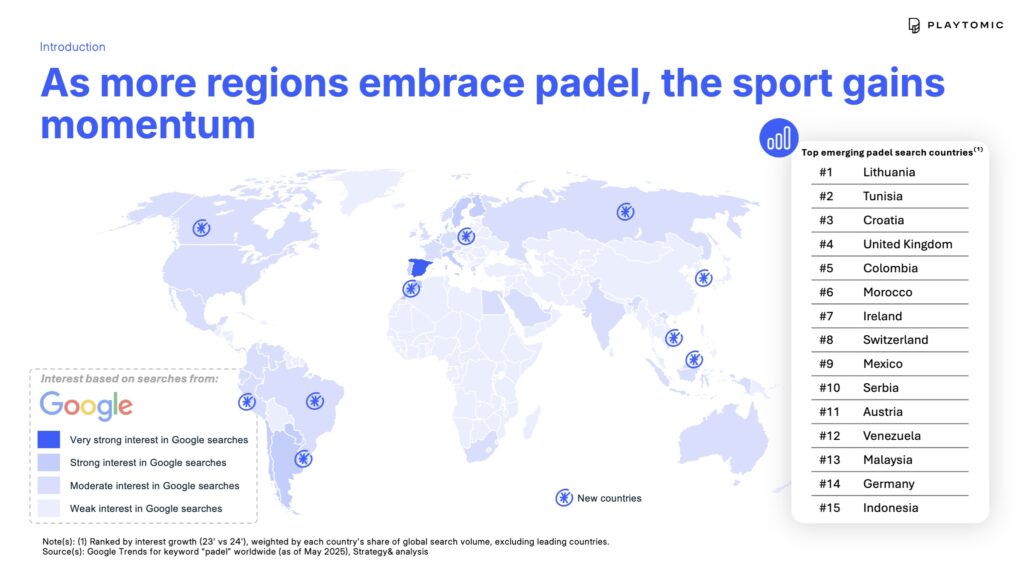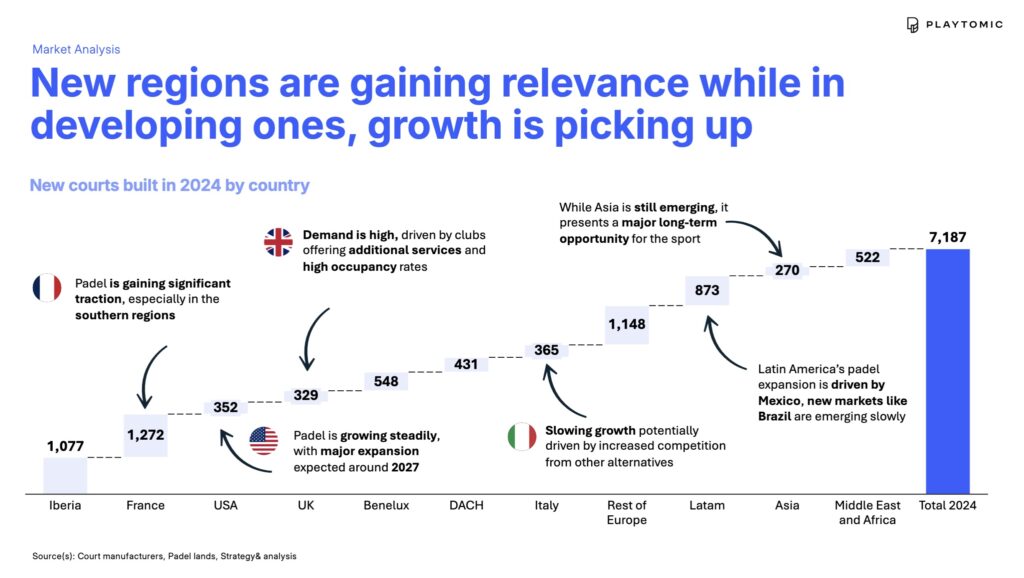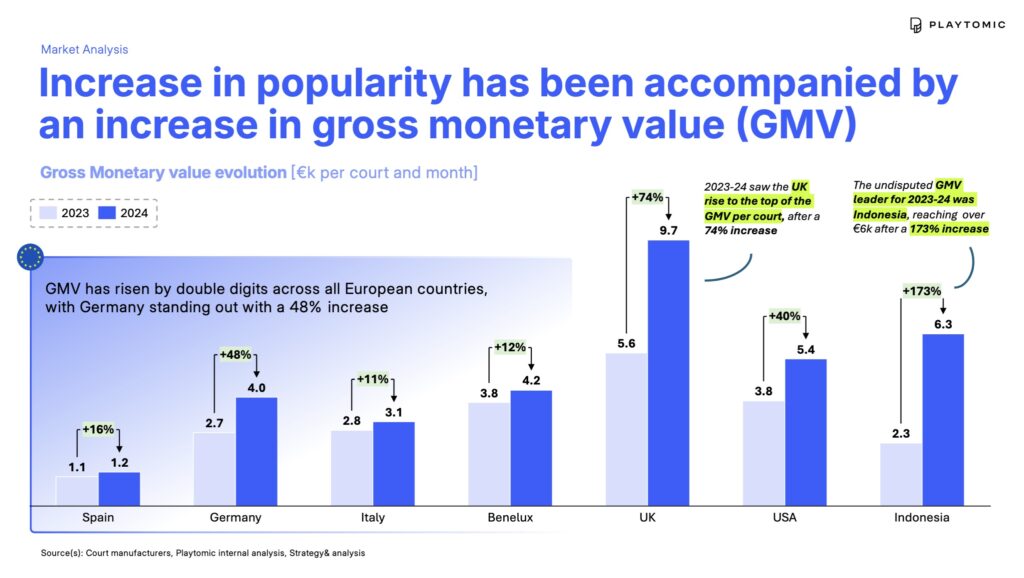The future is bright. The future is padel
Playtomic Global Padel Report 2025
Playtomic’s eagerly awaited 2025 Global Padel Report reveals the sport’s accelerated growth across the globe, with new clubs opening almost every two-and-a-half hours and the number of courts worldwide now exceeding 50,000.
The stats reveal that every day, somewhere in the world, nine new padel clubs throw open their doors, a year-on-year growth of 26% which, if continued, will deliver more than 20,000 clubs globally by the end of this year. By 2027 Playtomic predicts players will have access to more than 81,000 courts worldwide.
Padel is moving faster, harder and more sustainably than ever before. Markets are reaching maturity within just five to six years and countries such as France (particularly the south), the US (notably Miami, Texas, and California), and UK (including London, Manchester, and Bristol) are demonstrating strong momentum.
Sporting elite
Playtomic co-founder and CCO Pablo Carro said: “Padel has finally joined the top table of the world’s sporting elite. The 2025 Playtomic and PWC Global Padel Report highlights just how far padel is expanding and evolving. From emerging hotspots, to player behaviour and club performance, these insights are shaping the future of the sport.
“From the rapid momentum the sport is gaining in the United States, to the remarkable social and cultural phenomenon that we’re witnessing in the UK, the report proves that padel’s time within mainstream society has now arrived,” he added.
Padel has now entered mainstream society in the UK, the report states, with 329 courts built last year and high demand driven by ‘clubs offering additional services and high occupancy rates’. Interestingly, the UK leads on the highest worldwide gross monetary value per court (up 74% from 2023) and is still considered in its growth phase.
“Padel in the UK is steadily growing, with region-wide chains turning into nationwide ones. In addition to celebrity money, brands like Slazenger are increasingly involving themselves in the sport, either through acquisition or through organic growth,” states the report, identifying Glasgow, Leeds, Manchester, mid Wales, Bristol and London as the top five growth areas.
PwC’s Head of the Global Padel Report, Elena Martin, said: “We are delighted to see that the sector has returned to a path of organic and sustainable growth following the post-COVID activity surge and adjustments made in 2023. With more than 50,000 leads currently, development remains strong, particularly in key markets such as France and the United Kingdom. Our projections suggest that this growth momentum will continue in the years ahead.”
Padelnomics
The stats reveal how markets are maturing, moving from beginner-focussed activities to competitive open play – in emerging markets, bookings are dominated by classes and social events, helping players get started. As participation grows, players shift toward self-organised matches, a trend reflecting rising confidence and skill levels. In mature markets such as Spain and France, open matches now account for 80–90% of play and bring in more revenue for club operators.
The report examines rising padel hubs across the world and reports on specific markets, including the US – where padel is predicted to show the strongest worldwide growth to 2035 – India, the Middle East and Mexico. It also devotes seven pages to padel’s Olympic dream, the only place in the report referring to the percentage of female padel players – it cites 40% worldwide.
The overall takeaway – padel is growing faster and more sustainably, with stronger foundations in place.
Pablo Carro’s foreword in the report makes a fitting conclusion: “We are not just competing with other sports. We’re competing with every possible way people can spend their time and attention. In a world of overwhelming entertainment options and deep uncertainty, the relevance of padel will depend on our ability to create not just courts, but compelling experiences, sustainable, inclusive, and digitally native.
“This is a shared mission. Clubs are the frontlines, but federations, racket and apparel brands, court manufacturers, digital platforms, and players themselves, all carry part of the weight. The transition from exclusive to accessible, from traditional to tech-enabled, is already underway. We are no longer just growing, we are professionalising.”
Key findings
Global growth surge: Padel is now established in more than 90 countries, with high-growth markets including Portugal, the Netherlands, US, UK, UAE, Mexico, India and Indonesia. Growth has stabilised along a pre-COVID trajectory after reaching an all-time high, likely due to a backlog of court installations postponed during the pandemic.
Club openings increased by 26%, with 7,000 new courts built globally in 2024, signalling sustained growth across multiple regions. Even though growth rates vary by country, with some seeing gradual increases and others accelerating more rapidly, padel is now growing at a faster and more sustainable pace.
Classes and social events are the most common types of bookings in countries where padel is emerging; private reservations and open matches become predominant as players improve their skills.
US boom coming: Padel is gaining momentum in the US, with Florida, California and Texas standing out as the major hotspots, while New York, Massachusetts and Illinois are states where padel is emerging. While 352 courts were built across the country in 2024, a significant expansion is projected for 2027.
Tech-driven success: Padel clubs using digital tools like Playtomic are outperforming competitors by 3-5x, showing how data and smart booking are supercharging padel’s global ecosystem.
The ‘sticky sport’: With a 92% return rate, padel boasts an incredibly high return rate after just one session, driven by its accessibility, social nature and addictive gameplay.
Pickleball parallels: the two sports are increasingly co-existing with 30% of US pickleball venues offering padel – a significant shift from 12 months ago.
Olympic ambitions: with backing from the International Padel Federation (FIP), 2025 is a pivotal year for padel’s push toward inclusion in the Brisbane 2032 Olympic Games.
Playtomic Managing Director Antonio Robert Aragonés concluded: “Padel isn’t just gaining popularity, it’s driving a global movement. This report doesn’t just reflect the sport’s growth; it helps guide it. Positioned at the heart of padel’s global ecosystem, we offer an unmatched perspective through our data, technology and deep connection to the community.” 🎾









